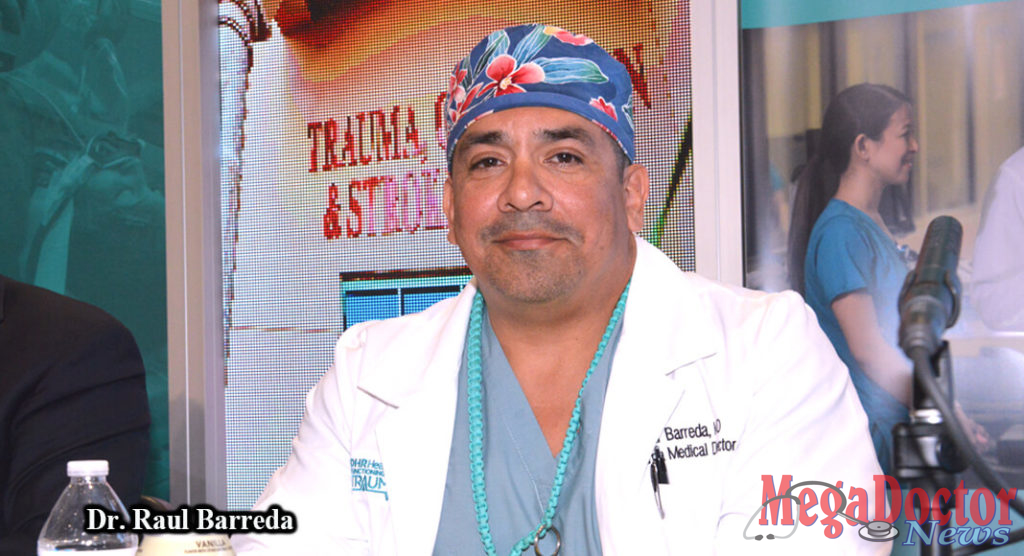Other Metros with a Third of the Population Enjoy Level 1 and 2 Trauma Centers

By Roberto Hugo Gonzalez
As originally published in Mega Doctor News newsprint edition June 2019
The special announcement made by Doctors Hospital at Renaissance on May 1, 2019, is still making waves throughout the region. The South Texas community has grown in population by leaps and bounds and bringing services like the Level 1 Trauma Emergency Center fills a definitive need for the area.
Dr. Raul Barreda asked, “Why does the Valley need a level 1? And my question to you is, why not? Why don’t we have a level 1?”
Dr. Barreda is Trauma Medical Director at DHR Health. He noted that the Valley’s documented population is 900,000 in Hidalgo County. He went on to say that Cameron County also shows another 500 to 600,000 in population.
“The ACS, American College of Surgeons, recommends that there should be a level 1 trauma center for every million people. There should be a level 1 trauma center within a 30-minute transport time. That’s not available now,” he explained.
Smaller metros have had level 1 and level 2 trauma centers for a long time. “If you look at Tyler, Texas, within their metropolitan area of 300,000 people; They have a level 1 center and a level 2 center,” he said. “Killeen and Temple metropolitan areas with 400,000 people; they also have level 1 and level 2 centers.” He continued, “Lubbock, with a population of 300,000 also enjoy level 1 center and two level 2 centers.”
Dr. Barreda said that between Hidalgo and Cameron Counties, they have about 1.5 million in population with two level 2 centers but no level 1 representation. He explained that the trauma network acts as a web, supporting each other throughout the State of Texas. “That’s the initiative driven by ACS when a center goes down, another center can pick up the slack.”
During this event, DHR Health hosted Dr. Kenneth Mattox, Chief of Staff and Surgeon-in-Chief at Ben Taub Hospital. Dr. Barreda said that Dr. Mattox has had the first-hand experience through Hurricanes Rita, Ike, and Harvey. He added that those hurricanes brought widespread disasters. “They know what happens when the network of the hospital goes down, and there’s no disaster preparedness. There is no web in place, there’s no backup plan.”
Dr. Barreda noted, “For these Gulf Coast regions that need disaster preparedness, we don’t have anything here. If Harvey hits in the Rio Grande Valley next year, we’re cut off. Who’s going to come to help us, and how are we going to transport people out?
“If Harvey hits San Antonio, we’re level 1, we can support, Houston can support. Texas is a web, no trauma center supports itself independently, nobody is on an island. Every level 1 needs the support of level 2; every level 1, needs level 3. The idea is to work together as a team, everybody has their responsibilities; everybody has a role.”
Dr. Barreda said that those critical trauma patients can get to the hospital, if possible, within 30 minutes; with the proper care, it helps the survival of the patients.
The South Texas area, according to Dr. Barreda, has had functioning level 2 trauma centers for approximately 3 to 4 years. “In the past three years, there have been 836 trauma patients transferred outside the area to San Antonio, just San Antonio, not counting Houston. 836 families had to go follow those patients,” he said.
He noted that approximately 200 of those cases may have been burned patients. They have to go to a burn center, but the majority of those other ones should have been attended here. He said, “Having displaced families with an economic burden and social support structures that were taken away, with missing work, and missing school is unacceptable.”
Dr. Barreda wanted to make sure everyone understood the importance of a level 1 trauma center. He asked, “Why don’t we have a level 1? Why are we underrepresented?”
The idea of competing with each other is what holds these communities back, it is not the answer. “We have to approach it as a team network. We have to be ready for the next disaster, and that’s the main purpose of level one. We need to educate disaster preparedness, get everybody ready, and on board.”
He told the audience that the State of Texas has 25 metropolitan areas and 2 metropolitan divisions. Hidalgo County ranks 5 and Cameron ranks 9. They were the only two metropolitan areas in the top ten that did not have a level 1 trauma center. “Why is that? Competition, or we don’t have the stuff together?”
Dr. Barreda said, “Today, the region has the strongest delegation of legislators that we’ve had in a long time representing us at the state level, we’re getting things done.”
On the other hand, he said that the physicians that are banded together and become one instead of contradicting each other, they become a lot stronger. Dr. Barreda also noted that the education component is vast.
“So, again, it’s not really congratulatory to me that we’re announcing and now functioning as a level 1 trauma center, it’s more an affirmation of something we’ve been doing all along. Now we’re just planting the flag,” Dr. Barreda finalized.









